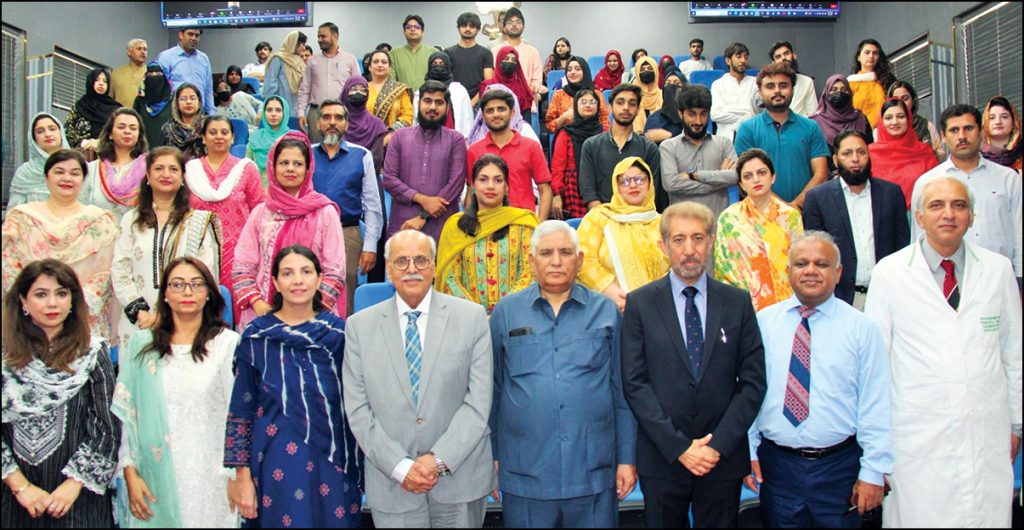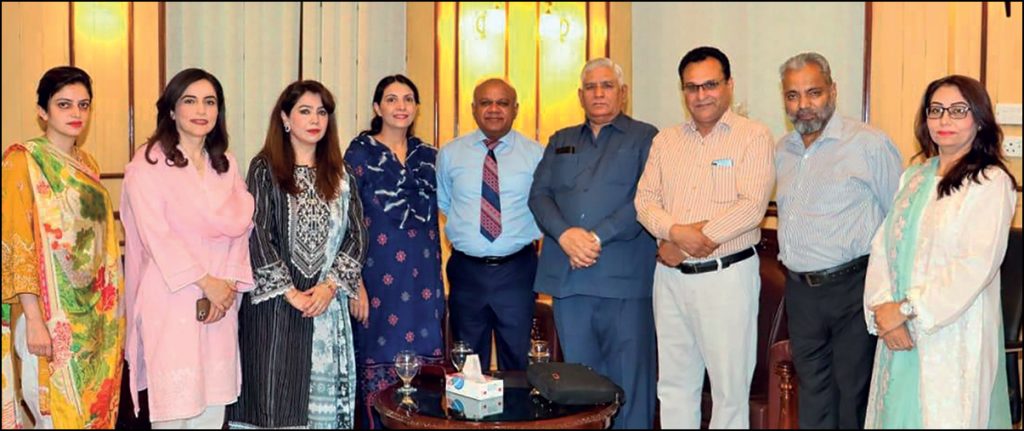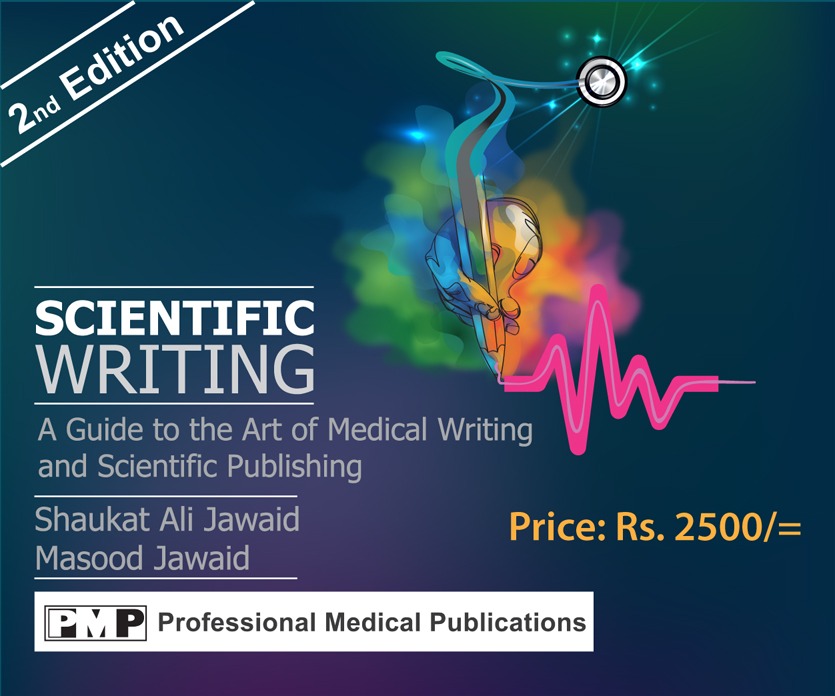Training session jointly organized by PM&DC, KEMU and PAME
highlight the salient features of criteria used for assessment
and evaluation of medical Journals
PM&DC Journals Committee members reiterate to facilitate
journals but no compromise on peer review and quality standards
LAHORE: Pakistan Medical & Dental Council in collaboration with King Edward Medical University and Pakistan Association of Medial Editors organized a training course entitled “Accreditation, Transparency and capacity building enhancing quality of medical journals” on June 8th 2024. One of the main objectives of organizing this academic activity was to assure complete transparency in assessment, evaluation and recognition of medical journals by the Pakistan Medial & Dental Council following the clearly laid down criteria in which peer review remains a central point. Good quality peer review is essential in maintaining standard of the journal.

Pakistan Medical & Dental Council in collaboration with KEMU and PAME organized a training workshop for Editors of medical journals at KEMU
Campus on June 8th 2024. Group photograph shows speakers and
participants along with VC KEMU Prof. Mahmood Ayaz and
Dr. Rukhsana Nisar in charge of Journals Section at PM&DC.
Prof. Saira Afzal was the main organizer while the other speakers who are also members of the PM&DC Journals committee included Prof. Major Gen.(Retd) Muhammad Aslam former Vice Chancellor of Univesity of Health Sciences, Prof. Akhtar Sherin Chief Editor Khyber Medical University Journal, Mr. Shaukat Ali Jawaid Chief Editor Pakistan Journal of Medical Sciences. Madam Rukhsana Nisar In charge Journal Section in PM&DC was also present on this occasion. In her brief introductory remarks she thanked KEMU, Prof.Saira Afzal and members of the Journals committee for helping in organizing this session. Similar sessions are also planned in other parts of the country, she added.
The proceedings of the session stated with a welcome address by Dr. Tehmina Asad on behalf of President PM&DC Prof. Rizwan Taj. She also commended the contributions by Prof. Shoaib Shafi former Chairperson of the Journals Committee on taking this initiative for staring these training workshops/sessions.
Prof. Mahmood Ayaz Vice Chancellor KEMU also graced the occasion with his presence. In his address he highlighted the importance of ensuring integrity of research and publications besides avoiding plagiarism. He also talked about how they had to face an embarrassing situation when during their visit to United States one of the researcher showed them how his research was plagiarized by authors and journal from Pakistan. At KEMU he said, we have now proper office for the journal with dedicated research officer and are determined to further improve the quality of our journals. Prof. Moin Pro Vice Chancellor also addressed the meeting and hoped it will help the editors in further improving their journals.

Some of the participants of the Training session organized by PM&DC,
KEMU and PAME photographed before the start of the session.
Prof. Saira Afzal Chief Editor Annals of KEMU was the first speaker who discussed the importance of peer review, different types of peer review. She also referred to the guidelines by International Committee of Medical Journal Editors (ICMJE) World Association of Medical Editors (WAME) and Committee on Publication Ethics (COPE) which the journals should follow. She also referred to Methodology quality in manuscript, importance of undertaking original research, quality of data, its analysis and interpretation. The editors she opined must adhere to ethical standards while post publication review is also important.
Mr. Shaukat Ali Jawaid described the salient features of criteria used for assessment, evaluation and recognition of medial journals by PM&DC. It is also available on the PM&DC website. Its important points include:
- The Journal website must contain comprehensive information about the journal, its aim and objective, ownership details, affiliation with any medical institution, professional specialty organization if any, frequency of publication, complete address with e mail and phone number of the Editor/Managing Editor, plagiarism policy, how they manage scientific misconduct. It is also advisable that the journal must have some mechanism of resolving any complaints against the journal by authors, reviewers or any other stake holders. Many reputed journals appoint Journal Ombudsman for this purpose.
- Each issue of the journal must have at least five original articles.
- Journal must ensure uniformity in structured abstract of every paper published. Similarly uniformity in other details like how to write page numbers in references must be ensured.
- Each manuscript must contain information about the Ethics Committee/IRB approval with reference number and the date of issue.
- In case of multicenter studies, if data is used from different hospitals, permission to use data for each healthcare facility should be obtained.
- In case there is no intervention, waiver certificate can be obtained from the EC/IRB.
- In case of papers from FCPS Dissertations, apart from synopsis approval from RTMC of CPSP, ethics committee approval is also needed to take care of the ethical issues.
- Journal website must have information about processing fee, publication charges, fast track processing policy if any and the fee. If there are no charges it should also be clearly stated.
- Journal should clearly state Peer Review Policy i.e. single blind, double blind or Open Peer Review System. Each manuscript must be reviewed by at least two reviewers.
- Journals should follow International Committee of Medical Journal Editors (ICMJE) latest guidelines regarding authorship as far as possible. There should be no place for Gift authorship and this intellectual corruption which is a menace must be checked.
- Each manuscript must have individual contribution details of each listed author.
- Each manuscript must contain information regarding conflict of interest, source of funding before the References.
- Each published manuscript must have information regarding timeline i.e. date on which the manuscript was received for publication, date of Revision received, in case of more than one revision, each revision date must be mentioned followed by the date on which the paper was accepted for publication.
- In case of Review articles, as per latest ICMJE guidelines, the Summary must contain information regarding the Data Bases used for literature search and the time period selected for this search.
- Authors must be asked to clarify if they have taken any assistance from ChatGPT or any other Artificial Intelligence Tools for the preparation of the manuscript and if so, that particular part must be mentioned to ensure transparency.
- While writing references, as per ICMJE Guidelines, in case of multiple authors, they must list up to six authors and then write et al.
- It is preferred that all published manuscripts should have a DOI number.
- Make sure that there are no discrepancies in formatting during page make up i.e. splitting references in two columns or two pages etc.
- Systematic review must follow PRISMA Guidelines
- Randomized Control Trials must be registered.
Suggestions
He suggested that every medical institution, professional specialty organization publishing a journal must have a proper office with minimum dedicated staff. Editors should have contract tenure appointment which can be extended reviewing their performance and accomplishments. Journals should have a separate account jointly operated by the Editor and representative of medical institution/ specialty organization so that they do not have to undergo un-necessarily delay in meeting urgent expenditures, ensuring timely payment to service providers. Editors, support staff should be offered certain privileges, incentives and it is extremely important to not only train but retain this support staff.
He also referred to the CME courses and Diploma in Medical Journalism being run by University of Health Sciences. CorTeach is also running an online course with collaboration of PAME members and it has helped to increase the number of Impact Factor journals in Pakistan from three to twelve. We wish that by 2030 we should have at least two dozen journals from Pakistan with Impact Factor but it cannot be realized unless the institutions organizations publishing the journals take interest and provide conducive environment. He thanked JPMA and JCPSP for their valuable input in these courses and specially thanked College of Physicians & Surgeons of Pakistan for its valuable help and assistance in promoting the discipline of medical journalism in Pakistan.
During the panel discussion it emerged that efforts are under way and some sort of joint committee of PM&DC and HEC may be formed in the days to come to evaluate and accredit the medical journals in Pakistan. PM&DC used to accredit the journals and it had derecognized some journals in 2018 but then the council was replaced by Pakistan Medical Commission (PMC). They passed on the accreditation of journals to HEC which recognized many sub-standard journals which have no peer review system at all and are bringing a bad name to the country.
A large number of faculty members have during the last few years got promoted by publishing their manuscripts in these sub-standard journals. Now when the PM&DC has been revived, its journals committee is reviewing, assessing and evaluating all the journals again. So far it has recognized ninety one journals; cases of a few others are under review while decision on some has been deferred due to serious shortcomings. Observations by committee member are conveyed to the respective journals and they are given ample opportunity to rectify the shortcomings before they are evaluated again. At times approval of minutes of the Journals Committee by the PM&DC Council does take some time.
Second Session
Prof. Akhtar Sherin was the first speaker in this session. In his presentation he highlighted the Errors and Oversight by the Editors, Challenges in PM&DC accreditation, compliance, copy editing and formatting besides Indexation in renowned databases. He showed snap shots from various journals which depicted the careless attitude of editors. He was of the view that the editors should not work as postman but they must have input in improving the contents. There are serious problems in formatting, poor quality of pictures are published. Tables are not properly prepared and it fails to convey the message to the reader. At times there are too many tables some of which are not required at all and one can convey the message in one sentence.
Timeline is not followed in published manuscripts stating when the paper was received, when it was reviewed and when it was accepted for publication. Website is poorly designed, gift authorship is very common. Editors he opined are gate keepers of quality hence they must do justice and realize their responsibilities.
Prof. Maj. Gen. Muhammad Aslam who is a renowned academician, has remained associated with Pakistan Armed Forces Medical Journal as editor and currently is chairman of the journals committee formed by the Higher Education Commission discussed in detail the criteria used by HEC for accreditation of journals. He also referred to HJRS used by the HEC, its salient features on which scoring is based, He laid emphasis on enhancing nurturing research quality which will help publication and standards of national journals. It is important that each manuscript is reviewed by two reviewers. HEC also looks at the Journal Prestige Index, Judge Journals Practices, Journals publishing stability etc.
In the past there was just one committee and it had no input from medical profession for evaluation of medical journals but now at least there is a separate committee which is a major positive development. In the days to come it is hoped, we will make further progress. HEC he further stated also looks at author’s fee, publication ethics, and sources for generation of revenue and quality control. Journals are also learning and their quality is improving.
During the discussion it was pointed out that those journals who are members of Directory of Open Access Journals (DOAJ) must be given some weight age. Another suggestion was the reviewers should also get some credit from HEC and PM&DC. Researchers conducting studies at Tehsil Hospitals, other healthcare facilities or in private practice were advised to take approval from Ethics Committee of nearby teaching hospital, medical Univesity but it is important. In case there is no intervention, they can seek waivers certificate from the EC/IRB. Responding to various questions regarding the use of Artificial Intelligence tools in scientific writing it was pointed out that use these AI tools intelligently, not for writing but for improvement of scientific writing and grammar. ChatGPT cannot be listed as author as it cannot take responsibility. Authors using these AI tools are required to mention and acknowledge its use and also mention the section of manuscript where their assistance has been taken to ensure transparency.
In the formal concluding session Prof. S.H. Waqar current President of Pakistan Association of Medical Editors (PAME) and Dr. Rukhsana Nisar in charge Journals Section at PM&DC briefly addressed the participants and highlighted the usefulness of such training sessions. The programme was moderated by Prof. Nazish Imran who has recently been nominated as Editor of Annals of KEMU.
Overall it was a very lively session very well attended by editors from Lahore and reviewers, faculty members besides over seventy editors joined online and listened to the presentations and also participated in the discussion. They expressed their appreciation for the organizers, PM&DC and KEMU, PAME and the speakers for highlighting various important issues related to quality, standard of manuscripts and journal publishing.



